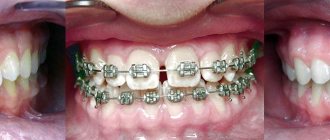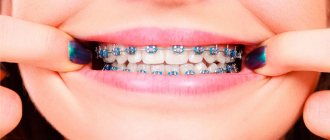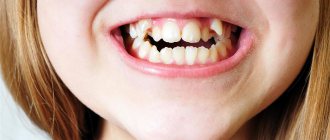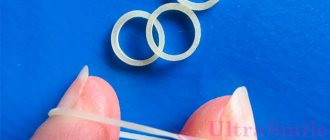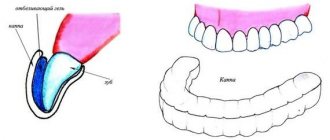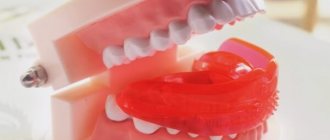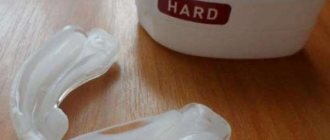Bite correction using Star Smile technology takes place at the dental clinic “On Smolenskaya” in several stages.
- At the first consultation, the doctor takes impressions and a panoramic image of the OPTG. The results of the examination are sent to the laboratory.
- Already during the second visit, the patient is shown a virtual setup - a three-dimensional video, which shows how the correction of irregularities in the dentition will occur and what the result will be.
- During treatment, the patient independently changes the aligners every two weeks, following the recommendations of the attending physician.
- Scheduled visits to monitor progress are carried out at intervals of 1-2 months.
To achieve results, you need to wear the aligners for up to 20-22 hours during the day - the aligners can be removed while brushing your teeth and eating. It is enough to follow simple rules of use and care - and the result in the form of perfectly straight, beautiful teeth will not take long to arrive!
“Physiological bite,” when the teeth are located symmetrically and the upper row overlaps the lower row by about a third, is very rare. There are many variants of the norm that do not require correction. However, in some cases, malocclusion becomes the cause of health problems, not to mention an unesthetic smile.
Dentists at the Na Smolenskaya clinic successfully practice correcting bites in adults using special mouth guards. This option looks more attractive than fixed orthodontic appliances (braces), which require strict hygiene. Now you can solve the problem comfortably without changing your usual lifestyle.
A mouthguard for correcting occlusion is a removable transparent orthodontic device made taking into account the individual characteristics of the patient. The aligner does not cause a foreign body sensation in the mouth, since it fits tightly to the teeth, repeating their location. The mouth guard puts constant pressure on the teeth, moving them in the desired direction.
For malocclusion correction to be effective, mouth guards must be worn on the teeth 22 hours a day. The aligner can be removed during meals and oral hygiene. At the start, the patient receives a set of trays and independently changes them as needed. The method is suitable for correcting any malocclusion.
Mouth guards as an alternative to braces
Straightening crooked teeth, of course, should be done in childhood. However, many parents simply do not pay attention to this problem. Therefore, the question of orthodontic treatment for most patients arises in adolescence or adulthood. However, not every teenager or adult will agree to put braces on their teeth and follow not the most simple rules of hygiene. Until recently, there was no alternative to braces. But with the advent of aligners - mouth guards for straightening teeth, it became possible to undergo orthodontic treatment unnoticed by others and with comfort for yourself. Moreover, this applies not only to adults, but also to teenagers, for whom their own technology of transparent mouth guards has been developed. Like aligners for adults, they are a set of removable aligners, completely invisible to others, which can correct most dental anomalies, provided that the attending physician has the appropriate experience.
How long should retainers be worn?
The duration of the retention period is on average 2 times longer than wearing braces, and patients who corrected their bite in adulthood - after 25-30 years, can wear retainers all their lives.
The length of time you wear retainers usually varies from person to person and depends on the following factors:
- Age of the orthodontic patient. The younger a person is, the faster his ligaments and muscles are rebuilt, thereby fixing the teeth and bite in the correct position. For patients who received braces as teenagers, wearing retainers for 6 months to 2 years is sometimes sufficient.
- Bad habits. People who smoke have poor blood supply and reduced immunity, so all processes of restructuring the position of teeth and healing are slower than in non-smokers.
- Oral health. If the teeth and periodontal tissues are healthy, the fixation of the ligamentous apparatus occurs faster.
- Complexity of the clinical case. The stronger the initial curvature of the teeth, the longer you need to wear a retainer.
The retention period must be carried out under the supervision of an orthodontist so that he monitors the condition of the bite. In any case, you should not stop wearing retainers without your doctor's approval, otherwise your teeth may become crooked again.
Features of a mouth guard for teeth straightening
Removable aligners for teeth straightening for adults are made from a special transparent material. Today, their range of applications is no different from the capabilities of braces, but treatment with mouth guards is much easier and more enjoyable. The main advantage of the system is that they are not visible, whereas braces, whether sapphire or ceramic, are still visible on the teeth. Of course, there are also lingual invisible braces, which are attached to the teeth from the inside, but they have a fairly long period of adaptation, just like other brace systems. Typically, it takes several weeks for the patient to adapt to braces, during which it will be uncomfortable for the wearer to eat and talk. In addition, braces, like other types of mouth guards, rub the mucous membrane and “scratch” the teeth, which causes some discomfort. But correcting a bite with a mouth guard is as comfortable as possible for patients.
What types of retention guards are there?
In clinical dentistry, there are several main types of aligners, which orthodontists select for their patients based on the problem. In particular, these are types of caps such as:
- Standard models
, which are made according to a single established pattern. They are inexpensive and easy to wear. But not everyone is ideally suited, since the physiology of patients is still different; - Thermoplastic options
, which are made from a special metal. When lowered into hot water, the structure becomes plastic; - Individual mouth guards.
This is a special type of aligner that is selected for each patient taking into account the characteristics of his jaw.
The dentist chooses the appropriate option after examining and removing the braces.
Transparent mouth guard for teeth straightening and trainers
Dental aligners for straightening teeth are often confused with trainers and retainers, which are worn after braces are removed. Meanwhile, these are completely different orthodontic devices, which have different indications for use and have different effects on the dental system. Trainers are somewhat reminiscent of sports mouthguards to protect teeth from impacts. With their help, it is possible to correct malocclusion and dental position in children from three years of age, which have developed as a result of impaired breathing and swallowing functions, as well as due to numerous childhood bad habits, such as prolonged sucking of a pacifier or bottle. Trainers are particularly effective for treating early stage malocclusions and are therefore mainly suitable for children under 11 years of age. A retainer is usually prescribed to consolidate the results of orthodontic treatment and adjust muscle function in accordance with the bite. It is bulkier than a clear aligner for adults and is made of flexible silicone.
How to properly care for your mouth guards?
Both trainers and aligners are quite easy to care for. It is necessary to remove the devices before eating. How to clean plaque from dental trays when you're done eating? You just need to rinse the device under warm water.
It is also not recommended to smoke in the aligners, as this may cause them to darken. And eventually they will become noticeable when you smile. At the clinic, the mouthguard always comes with a box in which you can put the aligner if necessary.
How to clean dental trays? For this you will need a toothbrush and toothpaste. It is advisable to clean the device both in the morning and in the evening. Proper hygiene is the key to the health of your teeth.
Silicone aligners for teeth straightening
Treatment with clear aligners minimizes the risk of medical error. The fact is that while wearing braces, the dentist takes a very active part and is independently involved in their installation and corrections, and in the process he may make a mistake. As a result, the course of treatment and, as a consequence, its outcome may be disrupted. In addition, during the next correction, there is a risk of “tightening” the ligature, which can cause severe pain and “eversion” of the roots of the teeth. A transparent mouthguard for straightening teeth for adults acts on hard tissues very smoothly and, if the doctor initially correctly calculated the trajectory of teeth movement, cannot disrupt the course of treatment.
Use of mouthguards for adults and children
Devices for adults, aligners, are mainly used to solve minor problems. They cannot cope with particularly difficult cases. Sometimes the reason for treatment with aligners rather than braces is an allergy to metals. After all, mouthguards are completely safe and biocompatible with the human body.
There are many types of trainers for children. The devices help wean the baby from bad habits (thumb sucking or pacifier). Trainers control the correct positioning of the tongue and the functioning of the facial muscles. As a result, the bite is formed correctly.
Plastic mouth guards for straightening teeth in teenagers
Despite all the advantages of plastic mouthguards, many people consider removable designs inappropriate for teenagers. The biggest concern of orthodontists and parents regarding orthodontic treatment with aligners is that the patient will constantly remove the appliance, and the entire treatment will go down the drain. The fact is that to achieve the desired effect, the structure must be on the teeth for at least 20 - 22 hours a day. Not all adults follow this immutable rule, let alone teenagers. For peace of mind, you can choose removable mouth guards for straightening teeth in teenagers with an indicator that changes color depending on how many hours the patient has been wearing it. If a teenager has worn a mouthguard too little, the indicator will show this.
Frequently asked questions about retainers:
Typically, patients who are thinking about installing braces learn about the need to wear a retainer during a consultation with an orthodontist. We have collected the most common questions that patients ask about the retention period.
How long to wear a retainer?
The minimum period for an adult patient is twice as long as the period of orthodontic treatment. Our recommended period is from 5 to 10 years, depending on the complexity of the case and the type of retention. Many patients do not feel the retainer on their teeth and quietly wear it all their lives.
Is it possible to do an MRI with a retainer?
Yes, an MRI can be done with a retainer, just like with braces, but due to the presence of metal in the mouth, there may be interference in the final image.
Do I need to change my permanent retainer?
If the retainer is not broken or unstuck, then there is no need to change it. To maintain good hygiene in the retainer area, use a single-tuft brush, brushes, dental floss, and regular professional hygiene.
Is there a warranty for the retainer?
In our clinic, the warranty on the retainer lasts 2 years. If during this time the retainer breaks or comes off, we will replace it absolutely free of charge.
Can teeth move apart if a retainer is installed?
If orthodontic treatment is completed correctly - the correct closure and position of the teeth is achieved, then with a permanent retainer, the teeth will remain in the correct position. If the retainer comes unstuck or breaks, you need to install it as quickly as possible, since even in a month your teeth can change position.
Night guard for straightening teeth
Imagine that there is a design for correcting your bite, which you only need to wear at night. It does not require any additional care other than simple cleaning once a day. Thus, it does not interfere with work, communication, eating and does not cause discomfort. Intrigued? We hasten to disappoint you. Unfortunately, nothing like this has yet been invented. But it’s hard not to agree that if a night guard existed, it would, without a doubt, be considered the most convenient to use and enjoy overwhelming success. However, correction of dental anomalies is a complex process that involves exposure to teeth over a certain period of time, and wearing aligners for less than 20 hours a day, unfortunately, will not be effective.
However, among the arsenal of orthodontic devices there are still devices that need to be worn only at night. They are called removable retainers and are used to consolidate the results after treatment with braces. The teeth do not immediately “get used” to the new position, so they often strive to return to their original position. Retainers prevent them from doing this and help keep their teeth perfectly straight.
Which is better: mouthguards or retainers?
Retention mouthguards and a non-removable retainer after orthodontic treatment are used in combination: a non-removable retainer from canine to fang is permanently placed on the teeth, the mouthguard is put on at night. After removing braces, we give patients 2 mouthguards: a night guard for all teeth in the upper dentition and a canine-to-canine safety mouthguard for the lower dentition, which is needed if the retainer breaks and there is no way to quickly make an appointment with an orthodontist. From the point of view of patient comfort, a non-removable retainer is more convenient than a mouth guard, since a week after installation, it is practically not felt in the mouth. And the mouth guards are quite bulky and it’s more difficult to get used to them.
Installing a mouthguard to straighten teeth
Aligners are much easier to install than braces, and they are also much more comfortable to wear and adjust. This procedure usually takes place in 3 stages.
- Diagnostics.
The doctor examines the patient for contraindications and diseases that must be eliminated before starting treatment. An accurate cast of the jaw is then made, which will serve as the basis for creating the mouthguards. - Manufacturing.
All data - x-ray, tomogram, jaw model - are sent to the company’s laboratory and processed in a special program. After this, a special device produces the required number of aligners to straighten the teeth. - Installation.
A person receives a set of products and recommendations for use. The specialist helps you put on the device, prescribes medications if necessary, and then sets a date for the next appointment. You will have to visit the orthodontist only once every one and a half to two months to monitor changes. The aligners do not require correction; the dentition is corrected by changing the set every two weeks.
How the aligners work
Aligners are custom-made, removable, thin, clear plastic trays molded to the shape of the dental arch that the orthodontist seeks to create. This is a mirror of the future of your bite - what it will look like in 2 weeks. They move the teeth into the desired position.
To do this, first an impression is taken from the patient's jaws and a plaster cast is created. The aligner is then created using special 3D modeling software.
How long does it take to make aligners?
Based on the created 3D simulation, the required number of pairs of mouthguards are manufactured and sent to you within a few weeks.
The aligners move the teeth in controlled steps and very gently. Each individual tray applies slight pressure to the teeth and thereby moves them into the desired position. At the beginning of each phase, patients usually feel a slight pressure, but after a few days the sensation disappears.
Depending on the course of treatment, you will receive from 3 to 9 pairs of aligners. They are changed every 2-3 weeks. Unlike braces, mouthguards do not have adjustable elements. Instead, new designs are created for each individual stage of treatment.
How long should you wear aligners to straighten your teeth?
The course of bite correction with mouth guards lasts on average from 9 to 18 months. The duration of treatment and the timing of wearing aligners depend on the degree of required tooth displacement and the individual plasticity of the patient’s bone tissue.
Is it possible to correct an overbite with aligners?
Only an orthodontist can definitely say whether aligners will help with a malocclusion, and only after an examination, a full examination and special calculations. Aligners are often used for minor orthodontic pathologies, and whether the aligners will correct the bite in your particular case will become known only after a comprehensive examination and an accurate diagnosis. The main use of these structures is correction and fixation after a course of treatment with braces.
What do aligners fix?
Treatment with plastic splints is possible for both mild and severe forms of incorrect position of the teeth and the entire bite.
The following pathologies can be corrected with the help of orthodontic aligners:
- Crowding of teeth: When there is a lack of space in the jaw, it causes the teeth to move in different directions, tilt and turn out. Due to the grouping of teeth and their incorrect position, gingivitis, periodontitis, and caries often develop; Oral hygiene becomes significantly more difficult.
- Wide gaps between teeth occur when the jaw is large and the teeth are naturally small or some of them are lost.
- Crossbites and reverse bites are pathologies of teeth closure, in which misalignment and incorrect overlap of some teeth with others occurs. This leads to the occurrence of periodontal diseases, faster wear of teeth and their forced early loss.
- A deep bite is a variant of pathological occlusion in which the teeth of one jaw overlap with others too much. This leads to frequent injuries, the development of periodontal disease and even more severe tooth displacement.
- Incorrect position of individual teeth: there are violations of the placement and position of teeth, such as tilting, rotation (turning around its axis), displacement in one direction or another.
Are there any contraindications to treating malocclusion with aligners?
There are no strict contraindications for the use of these drops. The main thing is to keep your teeth and gums healthy. Before correcting the bite, sanitation of the oral cavity is always carried out: treatment of caries and its complications, acute inflammatory processes, professional hygiene - all this will ensure a good prognosis for orthodontic treatment and increase the effectiveness of the aligners.
Does a mouthguard help straighten teeth?
The principle of operation of aligners is almost the same as that of braces - moving teeth into the correct position by applying pressure to them, but the impact of aligners is much gentler. An additional advantage is that this orthodontic design does not require correction; alignment occurs by changing sets.
In general, the effectiveness of aligners directly depends on production technology and a correctly drawn up treatment plan. Some manufacturers openly declare that their product can completely replace braces. Other brands correct both complex and simple dental anomalies, but indicate certain restrictions on indications. These details are always listed on the company’s website and, as a rule, are known to orthodontists.
However, there is one significant caveat. Even if you choose a reliable manufacturer and find a good specialist, the procedure will not give the expected result if you wear the product less than 20 hours a day and do not follow the doctor’s recommendations.
Pros and cons
The advantages of using mouthguards are considered to be:
- aesthetics (the mouthguard is not noticeable to others);
- no adjustment period (young patients forget about the device in their mouth within 1-2 hours from the moment of installation);
- ease of care;
- safety (hypoallergenic material does not cause irritation, and soft silicone does not scratch the baby’s oral mucosa);
- Convenience (self-installation and removal).
Disadvantages include limited treatment options (significant malocclusion requires the installation of braces) and the rather high cost of the structures.
Indications
The doctor will prescribe mouthguards for your child if:
- there is a diastema in the dentition (a significant gap between the front teeth);
- the teeth grow too close together, causing the crowns of the units to be pushed out of the row line;
- During the examination, the doctor discovered a pathology in the development of the jaw arch (too narrow or, on the contrary, wide).
Children, like adults, are susceptible to an insidious disease - bruxism. In this case, you cannot do without a nighttime dental guard for children, which can prevent chipping of the enamel and reduce the load on the jaw joint.
Children over 12 years of age often require treatment with braces, which takes 1-3 years. After completing the course, the dentist prescribes the wearing of aligners, which play the role of a kind of retainer - devices that help keep the teeth in the correct position and do not allow them to get into their usual position, reducing treatment with braces to zero.
Rules of care
Caring for your aligners is quite simple:
- clean and rinse with running water in a timely manner;
- store in a special container with holes;
- do not expose to mechanical stress or high temperatures;
- remove aligners from your mouth before eating;
Important: during treatment with mouthguards, you should not allow your child to chew chewing gum.
How much do teeth straightening trays cost?
Aligner aligners are one of the most expensive methods of bite correction, but their cost is fully justified by the effect and comfort of use. It is important to note that you should not trust manufacturers who immediately name a fixed amount - you can find out the full cost only after an examination and consultation with an orthodontist. Based on the complexity of the problem, the specialist will draw up a treatment plan, which will indicate the number of mouth guards required for this particular case, the frequency of visits to the doctor and additional structures. These criteria determine the final cost of treatment. All manufacturers of aligners must explain in detail to patients what factors affect the price of the product.
Advantages and disadvantages: what is better to know in advance?
We have already briefly described the comparison of aligners and braces for a child. For the bite and its formation, mouth guards will be a gentle tool. Positive features:
- simple removable device;
- no restrictions on food;
- no complications with hygiene procedures;
- the development of caries during wear is excluded;
- no damage to gums or enamel;
- quick addiction;
- preservation of the original appearance - transparent material is invisible.
Negative aspects may arise: you need to convince the child not to remove the children's mouth guards on their own in order to maintain the effect. Motivation from parents and doctors helps here. Among the disadvantages, we note that aligners are perceived as an expensive treatment option, although with a full calculation, you will be convinced that the final cost of a similar treatment with a brace system is comparable in cost.
Although these disadvantages seem insignificant if you focus on practicality and absence of pain. For children, these parameters seem to be the most important.
